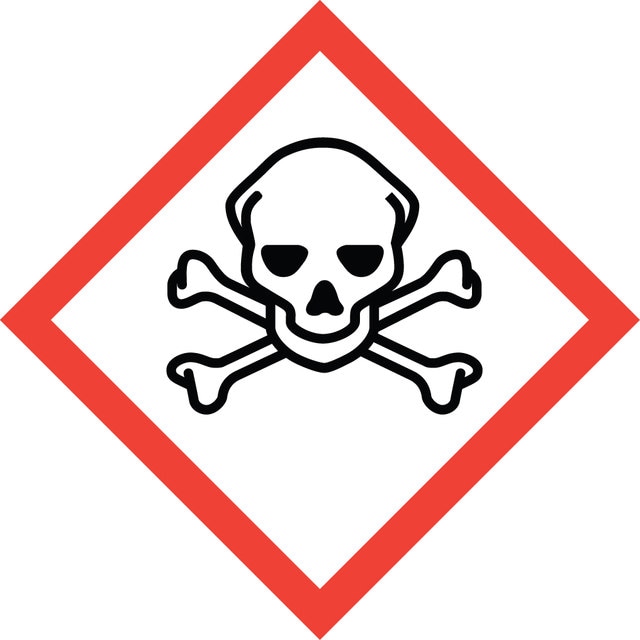Sign In to View Organizational & Contract Pricing
Select a Size
About This Item
Linear Formula:
BrCH2CH(OH)CH2Br
CAS Number:
Molecular Weight:
217.89
EC Number:
MDL number:
UNSPSC Code:
12352100
PubChem Substance ID:
NACRES:
NA.22
grade
technical grade
Quality Level
Assay
95%
form
liquid
refractive index
n20/D 1.552 (lit.)
bp
82-83 °C/7 mmHg (lit.)
density
2.136 g/mL at 25 °C (lit.)
functional group
bromo
hydroxyl
SMILES string
OC(CBr)CBr
InChI
1S/C3H6Br2O/c4-1-3(6)2-5/h3,6H,1-2H2
InChI key
KIHQZLPHVZKELA-UHFFFAOYSA-N
Looking for similar products? Visit Product Comparison Guide
Related Categories
General description
1,3-Dibromo-2-propanol is a dihalogenated alcohol. It is reported as bifunctional crosslinking reagent.
Application
1,3-Dibromo-2-propanol may be used in the following studies:
- To prepare the thioether ligand, used in the synthesis of palladium-phosphorus/sulfur nanoparticles.
- Preparation of 2-(alkoxy)propenyl bromide.
- Synthesis of 1,3-propanediamine derivatives connected to carbohydrates (sugar-pendant diamines).
- Chemical crosslinking of nine single substitution cysteine mutants of staphylococcal nuclease.
- Preparation of 1,3-dinitrooxy-2-propanol, via reaction with AgNO3 in MeCN at 80°C.
Signal Word
Danger
Hazard Statements
Precautionary Statements
Hazard Classifications
Acute Tox. 3 Oral - Carc. 2 - Eye Irrit. 2 - Flam. Liq. 3 - Skin Irrit. 2 - STOT SE 3
Target Organs
Respiratory system
Storage Class Code
3 - Flammable liquids
WGK
WGK 3
Flash Point(F)
116.6 °F - closed cup
Flash Point(C)
47 °C - closed cup
Personal Protective Equipment
dust mask type N95 (US), Eyeshields, Gloves
Regulatory Information
危险化学品
This item has
Choose from one of the most recent versions:
Already Own This Product?
Find documentation for the products that you have recently purchased in the Document Library.
M P Byrne et al.
Protein science : a publication of the Protein Society, 4(12), 2545-2558 (1995-12-01)
Nine single substitution cysteine mutants of staphylococcal nuclease (nuclease) were preferentially crosslinked at the introduced cysteine residues using three different bifunctional crosslinking reagents; 1,6-bismaleimidohexane (BMH), 1,3-dibromo-2-propanol (DBP), and the chemical warfare agent, mustard gas (bis(2-chloroethyl)sulfide; mustard). BMH and mustard gas
Heemal Dhanjee et al.
Tetrahedron letters, 51(42), 5609-5612 (2010-11-16)
2-(Alkoxy)propenyl bromides are readily prepared from 1,3-dibromo-2-propanol in a two-step sequence involving hydroxyl protection and sodium hydride-induced dehydrobromination. Indium-mediated allylation of aldehydes, ketones, and sulfonimines with 2-(alkoxy)propenyl bromides furnishes the corresponding homoallylic alcohols and sulfonamines in good yields. The products
Daisuke Kugimoto et al.
Polymers, 13(3) (2021-02-13)
Associating behavior of star-like amphiphilic polymers consisting of two or three poly(ethylene oxide) (PEO) chains and one stearyl chain (C18) was investigated. Although the aggregation number (Nagg) of linear analogue of amphiphilic polymers monotonically decreased with increasing number-average molecular weight
Hemant Joshi et al.
Nanoscale, 6(9), 4588-4597 (2014-03-15)
PdP2 and Pd4S nanoparticles (NPs) (size: ∼2-6 and 9-15 nm respectively) have been prepared for the first time from a single source precursor complex [Pd(L)Cl2] (1) by its one pot thermolysis at 200 °C in TOP and OA/ODE (1 : 1) respectively.
Y Mikata et al.
The Journal of organic chemistry, 66(11), 3783-3789 (2001-05-26)
A set of 1,3-propanediamine derivatives connected to carbohydrates (5) has been prepared in four steps from peracetylated sugar and 1,3-dibromo-2-propanol in 60-73% yields. D-Glucose, D-mannose, D-galactose, D-xylose, D-ribose, and maltose are utilized as sugar molecules in this work. The diamine
Our team of scientists has experience in all areas of research including Life Science, Material Science, Chemical Synthesis, Chromatography, Analytical and many others.
Contact Technical Service

